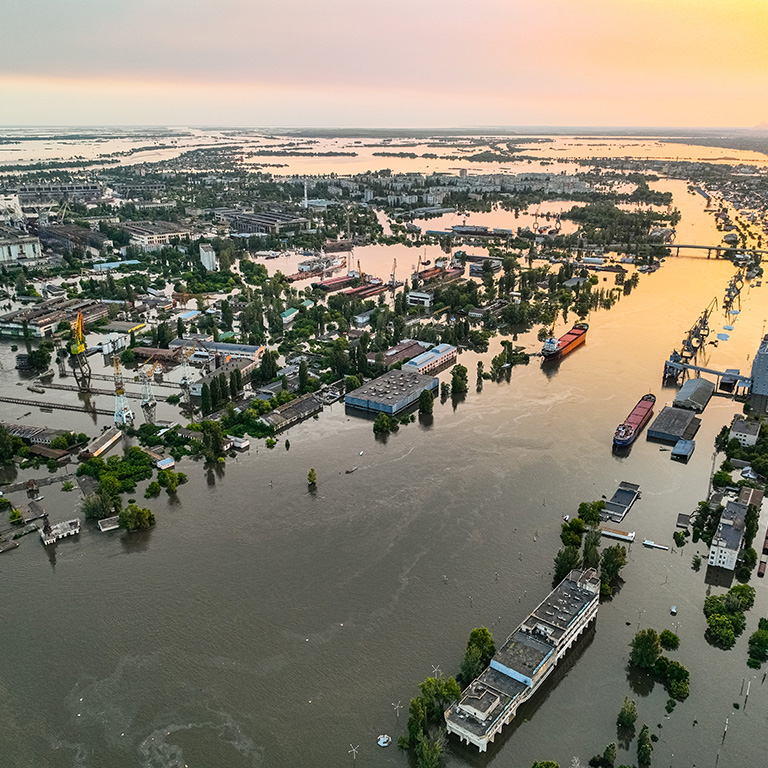
By Amy Barnes ,
Global Head of Energy & Power, Marsh
29/11/2023 · 5 minute read
Overlapping crises like conflict and flagging economic growth have created a complex risk landscape. But we can’t afford to take our eye off the ball when it comes to tackling climate change.
While investment in climate mitigation has accelerated in the past few years, the same cannot be said for climate adaptation. Whether this is because of a reluctance to appear defeatist or because resources and momentum are lacking, adaptation has lagged. Indeed, the adaptation finance gap has now widened to between $194 billion and $366 billion a year according to the UN Environment Programme.
This is concerning because the devastating effects of climate change are already with us, and we have no choice but to adapt. From Africa’s deadliest storm in over a century in Libya, to record-breaking numbers of $1 billion dollar disasters in the US, and severe flooding in India, China, Pakistan and Haiti, 2023 has demonstrated the need to safeguard lives and economies.
Against this alarming backdrop, COP28 is a vital moment for the global community to recognise the urgency of the climate crisis and build on the commitments made a year earlier at COP27. Adaptation should be high on the agenda.
We saw important but largely incremental advancements on the climate transition at COP27. A lack of ambition in some areas was disappointing but somewhat offset by a increased momentum in the business community.
Companies and state actors have been cooperating on greater climate action since COP27. Reporting, for example, is now far more widespread than it was. New requirements have recently taken effect in California that require many public and private organisations to publicly disclose their scope 1, 2 and 3 emissions, as well as their climate-related risks and efforts to address therm. Elsewhere, the International Sustainability Standards Board issued two inaugural standards which will provide the foundations of a global framework for sustainability disclosures.
These developments are important, but disclosure is not enough. We need to see the right regulatory incentives for companies to not only meet climate-related requirements but exceed them; we need more companies to want to do their best.
There also hasn’t been enough progress on establishing a common framework of what climate risk is, particularly in the context of de-risking the transition to renewable energy.
COP28 is an important opportunity to address this. Innovative technological solutions are being developed or scaled up to meet climate challenges but bring their own inherent – and sometimes previously unencountered – risks. We need to have important conversations about the risks of these technologies, we need to map them and forecast them, and we need to work to de-risk them so we can combat climate change effectively.
Looking back to COP27 once more, progress on adaptation was evident but not at the scale or speed the world needed. The Adaptation Fund received a welcome $243 million boost, whilst the summit fostered an historic agreement to create a loss and damage fund for those nations which have suffered the most from climate change. The latter is expected to feature prominently in this year’s agenda again.
A tentative agreement for the loss and damage fund to be administered by the World Bank was reached in November, but previous discussions had been fractious. This slow progress underscores the urgent need for deeper collaboration between stakeholders to seriously advance adaptation.
Placing adaptation at the top of the global climate agenda should be a key focus of COP28. We can take the event as an opportunity to highlight the benefits of adaptation innovations like parametric insurance products which are helping to close the protection gap, increasing the resilience of vulnerable communities and making it easier for insurers to play their part in climate action. We also need to highlight the importance of nature-based adaptation solutions to climate change, such as the protection and restoration of mangrove forests for coastal communities and demonstrate how the insurance industry can tackle the rising threat posed by extreme heat to workers’ health and global economies.
The finance gap for adaptation is a significant problem that needs addressing too. Financing was a key focus of COP27, and it will be again at COP28 as fulfilling the commitment made at COP26 to double financing for adaptation takes centre stage. Increasing capital flows to adaptation is important, but closing this gap is about more than just investment. It requires changing public perception around adaptation, increasing regulatory pressure and incentives, and providing frameworks for cooperation between public and private stakeholders.
We cannot allow short-term pressures to distract from the global climate trajectory. COP28 is a vital forum in which that message must be reinforced, and it represents an important opportunity for the insurance industry to show what it can do to help. We must push for greater alignment on supporting resilience in mature markets, and work to close the protection gap to ensure that no one gets left behind.
It’s easy to succumb to climate doom when we consider the enormity of the challenge before us, but COP28 should also be used as a platform to highlight some reasons to be optimistic about the transition. Even though adaptation is lagging, the strides made in climate mitigation have been immense; finance for mitigation increased by almost $500 billion from 2020 to 2022. Biodiversity is also high on the global agenda, and the power of global collaboration has never been more evident. It is now imperative that businesses and governments come together at COP28 to address fragilities in their systems, protect their assets and their people, and put adaptation as well as mitigation at the top of the climate agenda.

Report,Featured insight
19/09/2025

Article,Featured insight
15/09/2025